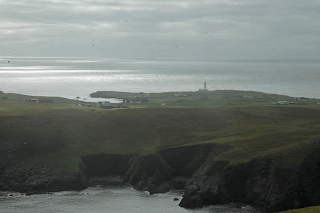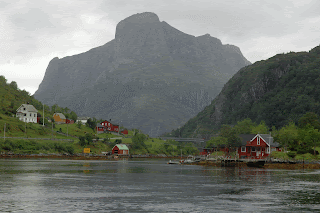It has been a while since I last posted a blog and I plead
pressure of work and a relentless but very rewarding programme. Although by accident rather than design, my own thoughts are now increasingly turning towards "farewell" but that's for another post!
For the last 3 weeks we have been hosts to an eclectic mix of people from the Cape Farewell foundation. The foundation (named after Cape Favel, the southern tip of Greenland and on the same latitude as Shetland - 60 degrees North) brings together artists and scientists with an interest in understanding and portraying the impact of climate change on the maritime environment and the communities who rely on that environment. By bringing people together, they hope to encourage a conversation to develop ideas and opportunity to network future projects. This year amongst other programmes they chartered Swan to cruise the Northern Isles of Orkney and Shetland.
 The crew of the Swan or indeed any boat have a primary
responsibility and focus to looking after her and this trumps other aspiration
and on occasions meant being unable to take part in the shore side
programme.
The crew of the Swan or indeed any boat have a primary
responsibility and focus to looking after her and this trumps other aspiration
and on occasions meant being unable to take part in the shore side
programme.
For the last 3 weeks we have been hosts to an eclectic mix of people from the Cape Farewell foundation. The foundation (named after Cape Favel, the southern tip of Greenland and on the same latitude as Shetland - 60 degrees North) brings together artists and scientists with an interest in understanding and portraying the impact of climate change on the maritime environment and the communities who rely on that environment. By bringing people together, they hope to encourage a conversation to develop ideas and opportunity to network future projects. This year amongst other programmes they chartered Swan to cruise the Northern Isles of Orkney and Shetland.
For me this has been a particularly rewarding 3 weeks. You may have already read my previous blog on
my visit to Long Hope on Hoy in Orkney and this was one opportunity seized from
their programme. You may also already know of, or discern, my
interest in personal and particularly youth development through expeditioning
and outdoor experience. Expeditions come
in many quizzes and take many forms. I
have long believed it a mistake to think of then exclusively in terms of being
some hard core activity in far flung corners of the globe. Successful and beneficial expeditions are to
be found on your door step. It’s all
about purpose and attitude of mind combined with learning and reflection. Not only has this been within that definition
but it has also been incredibly insightful and rewarding for me.
I suppose at one and perhaps mundane level
of delivery I enjoyed working with the group leader Ruth Little. On the face of it she and I might come from
very different experiences but right from our first exchange of e-mails I knew
this would be an easy and productive relationship. So I enjoyed the collaboration and whilst I
was at one level the bus driver for their expedition, I also had the
opportunity to facilitate and help deliver the experience. The groups (there were two separate ones) contained
a diverse mix of interests. There was
the Canadian venture capitalist investing into emerging renewables, there were
the poets and playwrights, there was the underwater cameraman, there was the ex
BAS marine biologist and ornithologist, writing a PhD on the impact of
pollution on deep water systems, there was the folk singer, the sound
recordists, the photographers and many many more.
Not only did this diverse range of interests
make for an exciting mix but more importantly so did such a diverse range of
people with their own equally valid perspectives.
Starting in Orkney we cruised several islands before heading
to Fair Isle and eventually on to Scalloway, where we started phase2 of the
expedition. Saying goodbye to the phase
1 participants was not easy and there is almost a cynical turncoat experience
as you say goodbye to one group and hello to another; loyalty and focus
shifting to the incomers. We then
cruised Shetland although we were unable to deliver the expected itinerary as the
weather forced several programme changes.
However this flexibility of programme ought to be easily understood as
inevitable when dealing with unknowns such as weather. It can also act as a metaphor for the need to
be receptive to changing situations and opportunities in life.
 The crew of the Swan or indeed any boat have a primary
responsibility and focus to looking after her and this trumps other aspiration
and on occasions meant being unable to take part in the shore side
programme.
The crew of the Swan or indeed any boat have a primary
responsibility and focus to looking after her and this trumps other aspiration
and on occasions meant being unable to take part in the shore side
programme.
However the itinerary did allowed me some opportunity to join in and
also follow my own interests. So as well
as Long Hope other highlights were a solo walk out to Muckle Flugga,
visiting
the Unst boat haven ( a fascinating private collection of local boats and
maritime artefacts)
Keeping tradition updated and preserved. sea gull engines on traditional yawls. local opinion is that the stern mount was less successful.
taking the inflatable into caves and through arches around fair Isle
John Rae's memorial in Kirkwall Cathedral. He was an artic explorer who amongst other achievements discovered the fate of the Franklin expedition


,
sightseeing in Kirkwall and climbing Orkney’s highest mountain.
John Rae's memorial in Kirkwall Cathedral. He was an artic explorer who amongst other achievements discovered the fate of the Franklin expedition


At most ports of call the Foundation had already created
links with local communities and also with specific individuals who were able
to add to the expedition, so whether it was the evening of Shetland dialect
poetry and fiddle music or the insight provided by a local archaeologist or an
explanation of local approaches and initiatives towards sustainable fishing and
marine conservation, we were privileged to fascinating evenings of informative
discussion and debate. Views were freely
and easily exchanged, sometimes profound opposite views were debated but always
there was a sense of respect and engagement with a desire to understand and
learn.
Of course such activity requires the odd jar or dram of
lubrication!
Now I would like to tell you more but the clock is against
me and “tide and weather wait for no man”. So I am going to cheat by providing
a link to their web site where you will also find a their own blog page
(including one from me) I really do encourage you to get a cup of coffee (or
similar) and follow the link below it because I almost guarantee that it will spark at least
one, and probably more than one, chain of thought that will leave you richer.

 cran baskets and below the official govt markings
cran baskets and below the official govt markings






























